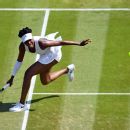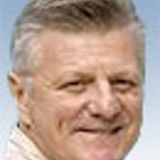4:02 pm | July 6, 2018 | Go to Source | Author:
WIMBLEDON — The score hung out there all morning, bobbing in the minds of some like some gaudy red balloon floating above Court No. 1: 4-6, 7-5, 7-6. It was the score by which 20-year old Taylor Fritz, the rising American pro, led Wimbledon’s No. 4 seed Alexander Zverev when their second-round match was suspended due to darkness on Thursday night.
Fritz is, in his own words, “a calm person.” His sleep was untroubled Thursday night despite being on the cusp of scoring a sensational upset. “I went to sleep thinking ‘I’m going to come back, take it from where I left off and finish off the match.'”
Zverev had other ideas. He pricked that red balloon, mounting a furious comeback that earned him the win a scant hour and two minutes after the resumption on a bright sunny afternoon, winning it 4-6, 7-5, 7-6 (0), 6-1, 6-2. It was a devastating performance by the German player, who already has eight ATP World Tour titles, three of them at blue-chip Masters 1000 events.
The lanky, 6-foot-6 winner is barely six months older than Fritz, who was welcomed as — perhaps — the second coming of Pete Sampras in 2016 when he reached the final of just the third ATP tour-level event he played. That made him the youngest American in an ATP final since 17-year-old Michael Chang won 1989 Wembley. Fritz scooped up the honors and quickly rose to career-high No. 53 on August 29, but he eventually stalled.
Unfortunately, ‘stalling” has become a prominent theme in U.S. tennis these days, although it’s a greater issue among the men than the women. This Wimbledon has become a prime example: Only No 9 seed John Isner, No. 11 Sam Querrey, Frances Tiafoe and Mackenzie McDonald reached the safe haven of round three, and Querrey lost on Friday as well (Tiafoe and Isner play on Saturday).
“Realistically we don’t have guys that are vying for slam titles right now,” Querrey said after his loss to Monfils. “We’ve got a lot of good players. You see John (Isner) wins (the) Miami (Open) and the younger guys are doing well. But I don’t think anyone’s put their money on them to win these Grand Slam events.”
Querrey doesn’t see any particular shortcoming in the American tennis development system, a patchwork quilt of strategies that includes a massive USTA (United States Tennis Association) effort as well as private tennis academies, ambitious freelancers, and cagey tennis parents. He points to the high-water mark of the 1990s and the generation led by Sampras and Andre Agassi, suggesting that all good things eventually come to an end.
“Then you had the dominance from Roger and Rafa the last 12 years,” Querrey added, ” Novak and Andy. We have dropped off. Maybe in 10 years we will have another wave back to some dominant Americans.”
Optimistic coaches and U.S tennis boosters have had to scale back their expectations somewhat since Fritz and a handful of his fellow young Americans, including Jared Donaldson, former .junior Grand Slam champions Reilly Opelka, Tommy Paul, Noah Rubin, Tiafoe and others popped on the radar and helped constitute the group marketed as #NextgenATP. But those players have been eclipsed by others in the same group from outside the U.S., including Zverev, Borna Coric, Denis Shapovalov, and Hyeon Chung. Still, four U.S. men are among the top 11 players in the not yet 21 category (Tiafoe, Fritz, Michael Mmoh, and Opelka).
Jim Courier, the U.S. Davis Cup captain and Tennis Channel analyst, has faith in the upcoming generation. “I like what I see, I like the collective nature of how the young guys are training and working in our (USTA) facilities in Orlando and Carson (Ca.),” Courier told me. “They’re pushing each other. Our strength and training program is becoming metrics based, to where it’s not longer an art but a science. Which is as it should be. We can now measure to determine if your players are fit, hitting their targets.”
Hitting those targets is becoming an increasingly demanding business for the players as they become bigger, faster, stronger. Fritz is 6-foot-4 and, while lean, he can bring it when he serves – he hit one at 136 mph against Zverev. Yet in the two sets played on Friday he was conspicuously outgunned.
Zverev and Fritz saw the drastic difference between the two days of their match through very different lenses. “He made some good adjustments today. I knew he was going to do that because he was letting me dictate too much last night,” Fritz said. .”He moved into the court a little and took time away from me. The rhythm on my serve and also my return just wasn’t the same today, and those are the two most important parts of my game.”
Fritz also said he had trouble with the sun on one side of the court when serving. “I don’t do well with changing my toss with the sun,” he explained. “I know it’s same for everybody, but I always had issues with it.”
Zverev said that he had a lot more to worry about when the match started on Thursday than Fritz’s blazing serve. For one thing, he was suffering from a stomach virus that caused him to throw up during the bathroom break he took at the end of the second set. He said he still felt felt poorly in the morning and avoided eating. “If I don’t feel well,” He remembered thinking, “it’s going to be one set. If I feel better, it might be two. I’ll go out there and try. Actually, the adrenaline pumped in. I felt great out there.”
Zverev wears contacts, and he also claimed that Court No. 1 became so dark that by 7:30 on Thursday he was playing virtually blind. “I was kind of searching for the ball, looking for it, especially on the returns,” he said. “I didn’t really panic because (today) I thought. ‘ If I play much better than yesterday, I knew that the conditions would help me. I could easily win that match.”
Powered by WPeMatico



